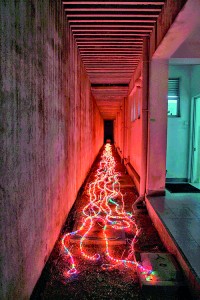‘Political Kitsch’ with a barbed edge
View(s):Pushpakumara’s early works have been expressionistic and his theme was mostly about the self and private life signed with tormented human figures. Those works were made with quick, sketchy and gestural brush strokes – in short they were kind of painted-drawings. Soon after the end of the 30-year war in 2009 Pushpakumara’s work took a turn – he more or less abandoned his quick and sketchy style of painting – to be specific, painting itself. With his abandonment of the gestural brush strokes, his obsessive positioning of the human figure in the centre of his work too changed.

Stands apart: The series on the illuminated barbed wire
The lonely human image that he kept painting over and over again throughout the war-years disappears – should I say ‘got displaced’ somewhere. It is revealing to note that this decentring or the displacement of the human image from his paintings happened in the aftermath of ‘ending the war’. Decentring/displacement of human image was replaced by overall patterned surfaces as if his attention is moved from the ‘subject’ to its ‘context’. The patterned surfaces of his current work in two dimensional and three dimensional forms have very specific intentions that explore the post war socio- political landscape.
Pushpakumara’s current body of works continues the departure he marked in 2009 with a remarkable proliferation of creative energy. Some of the works in this collection, look back to the expressionistic style that he tried to push aside, and brings it back with a freshened up energy. He has recaptured the idea of his kind of painting from a different path. Like some memories, some art-habits too don’t leave artists easily – they actually keep coming back in various guises. Some of the works in the current show speak for this inability of purging certain habits and pleasures from one’s idea of artistic-self. Pushpakumara reinvents the sketchiness of his earlier works in some of the works in the current show. One is struck by their similarity to his earlier works and then bemused by their differences and by the distance they try to make from his past. Here he infuses the technique of screen-printing to a painterly effect by way of repeated impressions of barbed wire, wall plugs, nails etc.
Pushpakumara’s current works share a few visual traits with a trend that emerged with the art of the 90s, which I have called the ‘Political Kitsch’. Several Sri Lankan artists began to work with kitsch material taking them as a particular system of knowledge production to intervene with contemporary social issues of Sri Lanka, especially in response to the war that ended in 2009 and the populist rhetoric that bolstered the idea of ‘war’. Sanath Kalubdana and Anura Krishantha, for example, have been working with kitsch materials for a long time in this vein. While their work usually incorporated an element of sarcasm or fun, Pushpakumara does the

Koralegedara Pushpakumara
opposite – the kitsch in his work tries to be serious and stern in most of the cases, while a work like ‘the illuminated barbed wire could be different, about which I have to say a few words at the end of this brief essay.
The primary trope in these works is the barbed wire – which is hardly a kitsch material but Pushpakumara manipulates it to be otherwise. He has been working with barbed wire and such hardware materials since 2009. He would bring a shiny and touchable surface to the barbed wire by encasing it in flexible plastic tubes – a skin to hide the true nature of barbed wire that is capable of inflicting pain. His intention was to capture the plight of the Tamil refugees who had to stay in refugee camps after the war and the apathy of the public in the south of Sri Lanka to this situation.
He first showed this series of work that uses barbed wire, hacksaw blades, tent-cloth and plastic casings in 2009 with an ironical title, ‘Goodwill Hardware’ in a series of three exhibitions curated under the concept of ‘skin’ in the ‘ 2009 Pradharshana Wasanthaya’ exhibition season of the Red Dot Gallery. Those exhibitions attempted to respond to a certain mood that was prevalent in the south of Sri Lanka in 2009 – a mood that constituted a glaring loss of empathy.
In the current show he presents us with a cross section of the entire range of works that he has produced over the past four years. The visual weavings that came about from a moment of loss continues to perpetuate itself, at times making digressions. The work that stands apart from his earlier works of the ‘hardware’ series is the ‘Illuminated Barbed Wire’ consisting running LED lights and plastic tubing that looks like a barbed wire laid on the floor. This work presenting the kitsch aspect more than in the other works, for me, suggests a sinister temper that tries to be some thing else, something deceitful.



